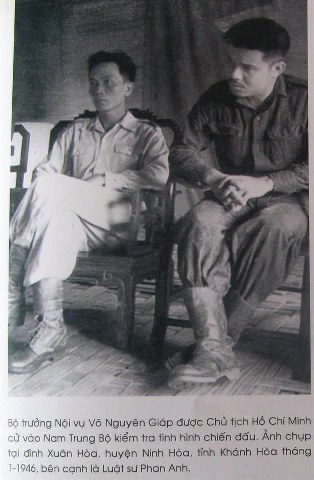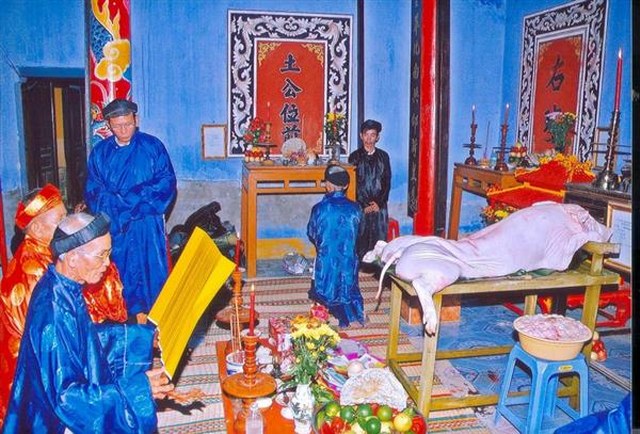Description
Xuan Hoa communal house is located in Xuan Hoa 2 village, Ninh Phung commune, Ninh Hoa town, Khanh Hoa province.
* Origin of relics
In 1653, the Vietnamese followed in the footsteps of Lord Nguyen Phuc Tan and settled in Khanh Hoa. At that time, along the lower reaches of Cai and Da rivers (Duc river), with about 20 to 25 households living, the main livelihoods were farming and fishing. The community of residents developed, they together built a village and named the village An Hoa (now Xuan Hoa village, Ninh Phung commune). The place "An Hoa" was found in the Khanh Hoa directory in 1810 as An Hoa commune, canton Trung, Tan Dinh district, Binh Hoa district[1].
Regarding the chronology, based on the horizontal phoenix hanging on the crossbar of the main hall with the content "...auspicious day in April, year of the Tiger, year of Tu Duc...", we can guess the age of the temple. Xuan Hoa's family was in 1866.
According to the past history and artifacts, Xuan Hoa communal house was bestowed with 05 ordinations by the Nguyen kings, but when it was sent to Linh Quang pagoda (Xuan Hoa village), it was lost.
Xuan Hoa communal house worships the following gods: Thanh Hoang, Tien Hien, Tho Cong, Thanh Nuong, Son Lam Lord general, Thuy Long goddess, Am Linh.
Xuan Hoa communal house has undergone renovations, which are the years: 1872, 1900, 1952, 1968

The overall plan of Xuan Hoa communal house
* Historical events taking place at the monument
During the period of resistance against the French colonialists, Xuan Hoa communal house was the place to witness many historical events as follows:
- Period before 1945: Xuan Hoa communal house was the secret operation site of the revolutionary base and also the place where revolutionary cadres mobilized the masses to directly participate in the July 16, 1930 protest. [2]. This is the first major struggle launched by the Indochinese Communist Party in the South Central region, following the struggle on the occasion of the International Labor Day 1/5 of Truong Thi, Ben Thuy (Nghe An) workers, contributing to the development of the country. the trigger for the revolutionary climax in the years 1930-1931.
- At the Nha Trang - Khanh Hoa Front in the resistance war against the French colonialists (from October 23, 1945 to February 1, 1946), Xuan Hoa communal house was the headquarters of the South Central Military Commission.


Documentary photo of General Vo Nguyen Giap on checking the fighting situation at Xuan Hoa communal house in 1946
In addition, Xuan Hoa communal house is also a military station for civil medicine, treating wounded soldiers fighting from the front lines[3]. Besides, in order to serve the resistance in Ninh Hoa, there was a wire connecting Ninh Hoa Post Office to the headquarters of the Military Commission for the South Central part located in Xuan Hoa (Ninh Phung)[4].
* Architecture of Xuan Hoa communal house
Xuan Hoa communal house turns to the south. The entire communal house architecture is located on a 2,352m2 wide ground, including the following architectural works: Nghi Mon, Phong Nha, Flag Tower, Temple of Lords Son Lam, Temple of Thuy Duc Thanh Quang, martial arts, main hall, Am Linh Temple, Thanh Nuong Temple (also known as Ba Temple), Tien Hien Temple, kitchen, canteen.
The whole structure of Xuan Hoa communal house is in Tam Son style, including 28 columns, including 12 female columns, 2 military columns, and 14 porch columns. Based on the current architectural structure, it can be recognized that the communal house was arranged in a continuous architectural style with 3 compartments 2 wings and all 3 compartments: Main hall, Thanh Nuong Temple, and Am Linh Temple are connected. systematically and intentionally. However, in order to separate each place and function of worship, the altars were separated from each other by a wall system. That has created a continuous unity in the wooden frame architectural structure, but there is a difference in the worship function of each room.
Every year, the community of residents of Xuan Hoa 1 and Xuan Hoa 2 villages organize the Xuan Hoa communal house festival according to the "Spring and Autumn two period" rule. In the spring (on the 10th day of the first lunar month), people organize vegetarian offerings, chanting prayers "National Thai people's peace". Autumn (in the 8th lunar month), people hold a festival lasting 2 days and 1 night. The communal house organizes annual boi singing, depending on the economic conditions contributed by the villagers every year.

The main ceremony at Xuan Hoa communal house
From the tangible and intangible cultural values of Xuan Hoa communal house, on August 31, 2011 Khanh Hoa Provincial People's Committee issued Decision No. 2353/QD-UBND ranking Xuan Hoa communal house relic as a historical relic - provincial culture.
Tran Thi Thanh Loan
[1] Nguyen Dinh Dau, 1997, Research on the geographical records of Nguyen Khanh Hoa dynasty, City Publishing House. Ho Chi Minh, HCM, p.87
[2] On July 16 every year, the Provincial Party Committee and People's Council of the province issued a resolution as "The traditional day of revolutionary struggle of the Party and people of Khanh Hoa province".
[3] Ministry of Information and Communications and Department of External Information, General Commander-in-Chief Vo Nguyen Giap, Information and Communication Publishing House, Hanoi.
[4] Nha Trang Khanh Hoa resistance war October 23, 1945, volume III (Documents and memoirs), Liaison Department October 23, Nha Trang Department of Van Hoa - Information Khanh Hoa province, 1996, p. seventy three.